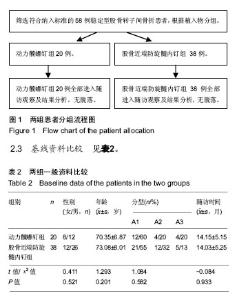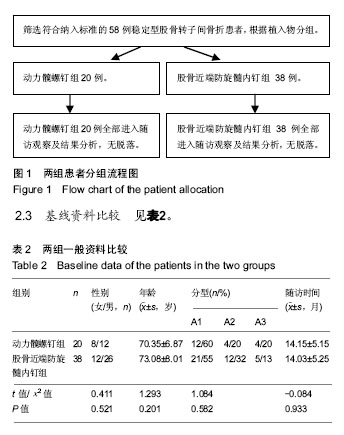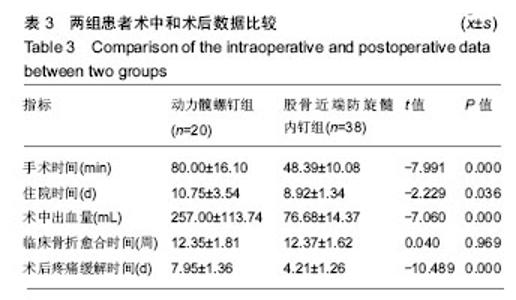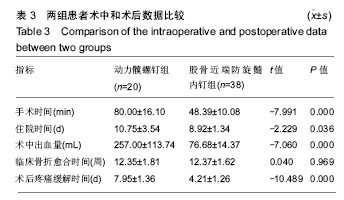Chinese Journal of Tissue Engineering Research ›› 2019, Vol. 23 ›› Issue (12): 1834-1839.doi: 10.3969/j.issn.2095-4344.1090
Previous Articles Next Articles
Short-term follow-up of dynamic hip screw versus proximal femoral nail anti-rotation for type AO/OTA A1 intertrochanteric femoral fracture in older adults
Tian Youyong, Wang Zhiyong
- Second Department of Orthopedics, Shanxi Fenyang Hospital, Fenyang 032200, Shanxi Province, China
-
Online:2019-04-28Published:2019-04-28 -
About author:Tian Youyong, Master, Attending physician, Second Department of Orthopedics, Shanxi Fenyang Hospital, Fenyang 032200, Shanxi Province, China
CLC Number:
Cite this article
Tian Youyong, Wang Zhiyong. Short-term follow-up of dynamic hip screw versus proximal femoral nail anti-rotation for type AO/OTA A1 intertrochanteric femoral fracture in older adults[J]. Chinese Journal of Tissue Engineering Research, 2019, 23(12): 1834-1839.
share this article
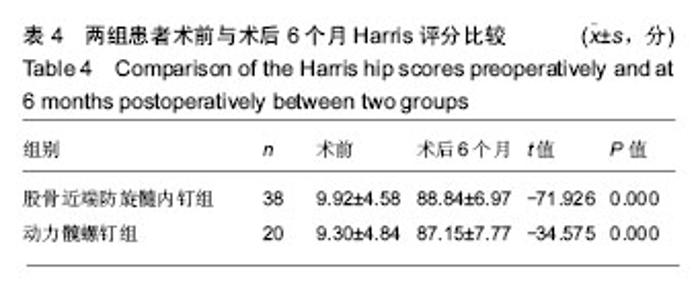
与动力髋螺钉组相比,股骨近端防旋髓内钉组具有较短的手术时间、较少的术中出血量,差异有显著意义(P < 0.05)。2组平均住院时间和术后疼痛缓解情时间比较也差异有显著性意义(P < 0.05),股骨近端防旋髓内钉组更具优势。 术后2组患者进行6-24个月随访。临床骨折愈合时间,动力髋螺钉组10-16周,平均(12.35±1.81)周,股骨近端防旋髓内钉组10-16周,平均(12.37±1.62)周,2组比较差异无显著性意义(t=0.040,P > 0.05)。2组患者术后3个月负重活动能力,动力髋螺钉组完全自主11例,单手杖7例,双拐或不能负重2例;股骨近端防旋髓内钉组完全自主20例,单手杖14例,双拐或不能负重4例,通过卡方检验进行统计分析,结果显示:χ2= 0.030,P > 0.05,表示2组之间差异无显著性意义。 2.5 术后髋关节功能 2组比较结果见表4。"
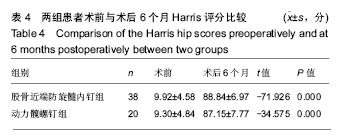
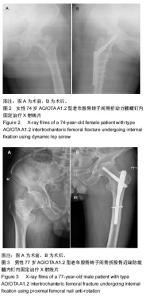
术后6个月评估患者髋关节Harris评分,动力髋螺钉组优7例,良10例,可2例,差1例,平均Harris评分(87.15±7.77)分;股骨近端防旋髓内钉组优19例,良15例,可2例,差2例,平均Harris评分(88.84±6.97)分,2组间术后比较差异无显著性意义(t=0.845,P > 0.05)。 2.6 术后不良反应 动力髋螺钉组1例伤口表浅感染,给予抗炎、换药、延迟拆线处理,伤口痊愈出院;1例髋内翻畸形愈合,患者未进一步处理。股骨近端防旋髓内钉组1例螺旋刀片切出,给予人工关节置换处理。2组其余患者骨折均骨性愈合。 2.7 典型病例 见图2,3。 2.8 植入物与宿主的生物相容性 2种植入物生物相容性良好,2组患者均未出现植入物周围感染、过敏反应、免疫反应及排斥反应。"

| [1] Guo Y, Yang H P, Dou Q J, et al. Efficacy of femoral nail anti-rotation of helical blade in unstable intertrochanteric fracture. Eur Rev Med Pharmacol Sci. 2017;21(3 Suppl):6-11.[2] Berger-Groch J, Rupprecht M, Schoepper S, et al. Five-year outcome analysis of intertrochanteric femur fractures: a prospective randomized trial comparing a 2-screw and a single-screw cephalomedullary nail. J Orthop Trauma. 2016; 30(9):483-488.[3] Gormeli G, Korkmaz MF, Gormeli CA, et al. Comparison of femur intertrochanteric fracture fixation with hemiarthroplasty and proximal femoral nail systems. Ulus Travma Acil Cerrahi Derg. 2015;21(6):503-508.[4] Stern R. Are there advances in the treatment of extracapsular hip fractures in the elderly? Injury. 2007;38 Suppl 3:S77-S87.[5] Muncibi F, Petrai V, Nistri L, et al. Advances in the surgical treatment of fragility fractures of the upper femur. Clin Cases Miner Bone Metab. 2009;6(3):197-202.[6] Ding T, Zhang B, Tian S, et al. [Selection principles and application status of surgical methods for hip fracture in the elderly]. Zhongguo Xiu Fu Chong Jian Wai Ke Za Zhi. 2018; 32(11):1435-1440.[7] Barton TM, Gleeson R, Topliss C, et al. A comparison of the long gamma nail with the sliding hip screw for the treatment of AO/OTA 31-A2 fractures of the proximal part of the femur: a prospective randomized trial. J Bone Joint Surg Am. 2010; 92(4):792-798.[8] Socci AR, Casemyr NE, Leslie MP, et al. Implant options for the treatment of intertrochanteric fractures of the hip: rationale, evidence, and recommendations. Bone Joint J. 2017;99-B(1): 128-133.[9] Jensen JS, Sonne-Holm S, Tondevold E. Unstable trochanteric fractures. A comparative analysis of four methods of internal fixation. Acta Orthop Scand. 1980;51(6):949-962.[10] Sharma A, Mahajan A, John B. A Comparison of the Clinico-Radiological Outcomes with Proximal Femoral Nail (PFN) and Proximal Femoral Nail Antirotation (PFNA) in Fixation of Unstable Intertrochanteric Fractures. J Clin Diagn Res. 2017;11(7):C5-C9.[11] Jia L, Zhang K, Wang ZG, et al. Proximal femoral nail antirotation internal fixation in treating intertrochanteric femoral fractures of elderly subjects. J Biol Regul Homeost Agents. 2017;31(2):329-334.[12] Ma KL, Wang X, Luan FJ, et al. Proximal femoral nails antirotation, Gamma nails, and dynamic hip screws for fixation of intertrochanteric fractures of femur: A meta-analysis. Orthop Traumatol Surg Res. 2014;100(8):859-866.[13] 聂治军,常彦海,袁启令,等. 三种手术方式治疗高龄不稳定性股骨粗隆间骨折的对比研究[J].中华关节外科杂志(电子版), 2017, 11(2):17-23.[14] 程建,雷会宁,冯仕明,等. PFNA与DHS治疗不稳定型股骨粗隆间骨折的Meta分析[J]. 重庆医学, 2016,45(21):2956-2961.[15] Singh AK, Narsaria N, G RA, et al. Treatment of unstable trochanteric femur fractures: proximal femur nail versus proximal femur locking compression plate. Am J Orthop (Belle Mead NJ). 2017;46(2):E116-E123.[16] 王武,翟生,韩小平,等. 股骨近端抗旋髓内钉与动力髋螺钉对老年不稳定股骨粗隆间骨折疗效的对比研究[J]. 中华医学杂志, 2018,98(5):357-361.[17] Shin YS, Chae JE, Kang TW, et al. Prospective randomized study comparing two cephalomedullary nails for elderly intertrochanteric fractures: Zimmer natural nail versus proximal femoral nail antirotation II. Injury. 2017;48(7): 1550-1557.[18] Lee CH, Su KC, Chen KH, et al. Impact of tip-apex distance and femoral head lag screw position on treatment outcomes of unstable intertrochanteric fractures using cephalomedullary nails. J Int Med Res. 2018;46(6):2128-2140.[19] 吴在德,吴肇汉,郑树,等. 外科学[M]. 7版. 北京:人民卫生出版社, 2008.[20] Harris WH. Traumatic arthritis of the hip after dislocation and acetabular fractures: treatment by mold arthroplasty. An end-result study using a new method of result evaluation. J Bone Joint Surg Am. 1969;51(4):737-755.[21] Matassi F, Carulli C, Munz G, et al. Preliminary results of an early vs delayed timing of surgery in the management of proximal femur fragility fractures. Clin Cases Miner Bone Metab. 2015;12(1):11-17.[22] Yonezawa T, Yamazaki K, Atsumi T, et al. Influence of the timing of surgery on mortality and activity of hip fracture in elderly patients. J Orthop Sci. 2009;14(5):566-573.[23] Steinberg EL, Blumberg N, Dekel S. The fixion proximal femur nailing system: biomechanical properties of the nail and a cadaveric study. J Biomech. 2005;38(1):63-68.[24] Xie H, Wang Z, Zhang J, et al. Clinical outcome of dynamic hip locking plates and proximal femoral nails anti-rotation-Asia for treating intertrochanteric femur fracture with lateral wall fractures in the elder patients. Oncotarget. 2017;8(47):82700-82704.[25] Carulli C, Piacentini F, Paoli T, et al. A comparison of two fixation methods for femoral trochanteric fractures: a new generation intramedullary system vs sliding hip screw Clin Cases Miner Bone Metab. 2017;14(1):40-47.[26] Sharma A, Sethi A, Sharma S. Treatment of stable intertrochanteric fractures of the femur with proximal femoral nail versus dynamic hip screw: a comparative study. Rev Bras Ortop. 2018;53(4):477-481.[27] 徐驰,周勇,赵军,等. PFNA治疗老年股骨转子间骨折的隐性失血分析[J]. 中国矫形外科杂志, 2018,26(6):510-515.[28] 吴强,杨旭,王欣. 髓内固定对股骨转子间骨折隐性失血的影响[J]. 中华实验外科杂志, 2017,34(4):630.[29] 龙秋平,廖前德,尹科,等. 股骨转子间骨折两种置入内固定的隐性失血比较[J]. 中国组织工程研究, 2013,17(30):5460-5465.[30] 王峰,李振武,尹锐锋,等. 老年股骨转子间骨折围修复期隐性失血量与内固定植入物及性别的关系[J]. 中国组织工程研究, 2016,20(4):544-548. |
| [1] | Zhang Tongtong, Wang Zhonghua, Wen Jie, Song Yuxin, Liu Lin. Application of three-dimensional printing model in surgical resection and reconstruction of cervical tumor [J]. Chinese Journal of Tissue Engineering Research, 2021, 25(9): 1335-1339. |
| [2] | Zeng Yanhua, Hao Yanlei. In vitro culture and purification of Schwann cells: a systematic review [J]. Chinese Journal of Tissue Engineering Research, 2021, 25(7): 1135-1141. |
| [3] | Xu Dongzi, Zhang Ting, Ouyang Zhaolian. The global competitive situation of cardiac tissue engineering based on patent analysis [J]. Chinese Journal of Tissue Engineering Research, 2021, 25(5): 807-812. |
| [4] | Wu Zijian, Hu Zhaoduan, Xie Youqiong, Wang Feng, Li Jia, Li Bocun, Cai Guowei, Peng Rui. Three-dimensional printing technology and bone tissue engineering research: literature metrology and visual analysis of research hotspots [J]. Chinese Journal of Tissue Engineering Research, 2021, 25(4): 564-569. |
| [5] | Chang Wenliao, Zhao Jie, Sun Xiaoliang, Wang Kun, Wu Guofeng, Zhou Jian, Li Shuxiang, Sun Han. Material selection, theoretical design and biomimetic function of artificial periosteum [J]. Chinese Journal of Tissue Engineering Research, 2021, 25(4): 600-606. |
| [6] | Liu Fei, Cui Yutao, Liu He. Advantages and problems of local antibiotic delivery system in the treatment of osteomyelitis [J]. Chinese Journal of Tissue Engineering Research, 2021, 25(4): 614-620. |
| [7] | Li Xiaozhuang, Duan Hao, Wang Weizhou, Tang Zhihong, Wang Yanghao, He Fei. Application of bone tissue engineering materials in the treatment of bone defect diseases in vivo [J]. Chinese Journal of Tissue Engineering Research, 2021, 25(4): 626-631. |
| [8] | Zhang Zhenkun, Li Zhe, Li Ya, Wang Yingying, Wang Yaping, Zhou Xinkui, Ma Shanshan, Guan Fangxia. Application of alginate based hydrogels/dressings in wound healing: sustained, dynamic and sequential release [J]. Chinese Journal of Tissue Engineering Research, 2021, 25(4): 638-643. |
| [9] | Chen Jiana, Qiu Yanling, Nie Minhai, Liu Xuqian. Tissue engineering scaffolds in repairing oral and maxillofacial soft tissue defects [J]. Chinese Journal of Tissue Engineering Research, 2021, 25(4): 644-650. |
| [10] | Xing Hao, Zhang Yonghong, Wang Dong. Advantages and disadvantages of repairing large-segment bone defect [J]. Chinese Journal of Tissue Engineering Research, 2021, 25(3): 426-430. |
| [11] | Chen Siqi, Xian Debin, Xu Rongsheng, Qin Zhongjie, Zhang Lei, Xia Delin. Effects of bone marrow mesenchymal stem cells and human umbilical vein endothelial cells combined with hydroxyapatite-tricalcium phosphate scaffolds on early angiogenesis in skull defect repair in rats [J]. Chinese Journal of Tissue Engineering Research, 2021, 25(22): 3458-3465. |
| [12] | Wang Hao, Chen Mingxue, Li Junkang, Luo Xujiang, Peng Liqing, Li Huo, Huang Bo, Tian Guangzhao, Liu Shuyun, Sui Xiang, Huang Jingxiang, Guo Quanyi, Lu Xiaobo. Decellularized porcine skin matrix for tissue-engineered meniscus scaffold [J]. Chinese Journal of Tissue Engineering Research, 2021, 25(22): 3473-3478. |
| [13] | Mo Jianling, He Shaoru, Feng Bowen, Jian Minqiao, Zhang Xiaohui, Liu Caisheng, Liang Yijing, Liu Yumei, Chen Liang, Zhou Haiyu, Liu Yanhui. Forming prevascularized cell sheets and the expression of angiogenesis-related factors [J]. Chinese Journal of Tissue Engineering Research, 2021, 25(22): 3479-3486. |
| [14] | Liu Chang, Li Datong, Liu Yuan, Kong Lingbo, Guo Rui, Yang Lixue, Hao Dingjun, He Baorong. Poor efficacy after vertebral augmentation surgery of acute symptomatic thoracolumbar osteoporotic compression fracture: relationship with bone cement, bone mineral density, and adjacent fractures [J]. Chinese Journal of Tissue Engineering Research, 2021, 25(22): 3510-3516. |
| [15] | Liu Liyong, Zhou Lei. Research and development status and development trend of hydrogel in tissue engineering based on patent information [J]. Chinese Journal of Tissue Engineering Research, 2021, 25(22): 3527-3533. |
| Viewed | ||||||
|
Full text |
|
|||||
|
Abstract |
|
|||||
